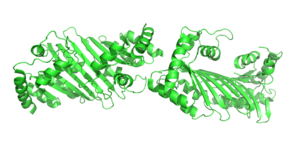APOBEC

| APOBEC-like N-terminal domain | |||||||||
|---|---|---|---|---|---|---|---|---|---|
| Identifiers | |||||||||
| Symbol | APOBEC_N | ||||||||
| Pfam | PF08210 | ||||||||
| InterPro | IPR013158 | ||||||||
| |||||||||
| APOBEC-like C-terminal domain | |||||||||
|---|---|---|---|---|---|---|---|---|---|
| Identifiers | |||||||||
| Symbol | APOBEC_C | ||||||||
| Pfam | PF05240 | ||||||||
| InterPro | IPR007904 | ||||||||
| |||||||||
APOBEC ("apolipoprotein B mRNA editing enzyme, catalytic polypeptide") is a family of evolutionarily conserved cytidine deaminases.
Function
[edit]A mechanism of generating protein diversity is mRNA editing. The APOBEC family of proteins perform mRNA modifications by deaminating cytidine bases to uracil. The N-terminal domain of APOBEC-like proteins is the catalytic domain, while the C-terminal domain is a pseudocatalytic domain. More specifically, the catalytic domain is a zinc dependent cytidine deaminase domain and is essential for cytidine deamination. The positively charged zinc ion in the catalytic domain attracts to the partial-negative charge of RNA.
In the case of APOBEC-1, the mRNA transcript of intestinal apolipoprotein B is altered. RNA editing by APOBEC-1 requires homodimerization and this complex interacts with RNA-binding proteins to form the editosome.[2] The resulting structure interacts with the codon CAA at codon 2153 and deaminates it into UAA, producing a stop codon that results in mRNA that is translated into the intestinal apoB-48 isoform.[3] For other APOBEC-modified transcripts such as in the site-specific deamination of a CGA to a UGA stop codon in neurofibromatosis type 1 (NF1) mRNA, the resulting proteins are predicted to be truncated as well, although these transcripts are possibly degraded.[4]
C-to-U modifications do not always result in the truncation of proteins. For example, in humans/mammals they help protect from viral infections.[5][6] APOBEC family proteins are widely expressed in cells of the human innate immune system.[7]
Cancer
[edit]These enzymes, when misregulated, are a major source of mutation in numerous cancer types.[5][6][8] When the expression of APOBEC family proteins is triggered, accidental mutations in somatic cells can lead to the development of oncogenes, cells which have the potential to develop into a tumor. APOBEC proteins are further expressed in attempt to regulate tumor formation. This makes APOBEC proteins a helpful marker for diagnosing malignant tumors.[9]
Structure
[edit]A 2013 review discussed the structural and biophysical aspects of APOBEC3 family enzymes.[10] Many of the APOBEC protein features are described in the widely studied APOBEC3G's page.[tone]
Family members
[edit]Human genes encoding members of the APOBEC protein family include:
- APOBEC1
- APOBEC2
- APOBEC3A
- APOBEC3B
- APOBEC3C
- APOBEC3D ("APOBEC3E" now refers to this)
- APOBEC3F
- APOBEC3G
- APOBEC3H
- APOBEC4
- Activation-induced (cytidine) deaminase (AID)
References
[edit]- ^ PDB: 2NYT; Prochnow C, Bransteitter R, Klein MG, Goodman MF, Chen XS (January 2007). "The APOBEC-2 crystal structure and functional implications for the deaminase AID". Nature. 445 (7126): 447–451. Bibcode:2007Natur.445..447P. doi:10.1038/nature05492. PMID 17187054. S2CID 4394772.; rendered using PyMOL.
- ^ Wedekind JE, Dance GS, Sowden MP, Smith HC (April 2003). "Messenger RNA editing in mammals: new members of the APOBEC family seeking roles in the family business". Trends in Genetics. 19 (4): 207–216. doi:10.1016/S0168-9525(03)00054-4. PMID 12683974.
- ^ McKusick VA, Hamosh A (19 December 2019) [Originally published 27 September 1994]. "APOLIPOPROTEIN B mRNA-EDITING ENZYME, CATALYTIC POLYPEPTIDE 1; APOBEC1". Online Mendelian Inheritance in Man. Retrieved 23 December 2023.
- ^ Blanc V, Davidson NO (January 2003). "C-to-U RNA editing: mechanisms leading to genetic diversity". The Journal of Biological Chemistry. 278 (3): 1395–1398. doi:10.1074/jbc.r200024200. PMID 12446660.
- ^ a b "Unexpected DNA-Binding Mechanism Suggests Ways to Block Enzyme Activity in Cancer". Dec 2016.
Based on ("Structural Basis for Targeted DNA Cytosine Deamination and Mutagenesis by APOBEC3A and APOBEC3B") online in Nature Structural and Molecular Biology.
- ^ a b Cervantes-Gracia K, Gramalla-Schmitz A, Weischedel J, Chahwan R (November 2021). "APOBECs orchestrate genomic and epigenomic editing across health and disease". Trends in Genetics. 37 (11): 1028–1043. doi:10.1016/j.tig.2021.07.003. PMID 34353635. S2CID 236934922.
- ^ Koito A, Ikeda T (2013). "Intrinsic immunity against retrotransposons by APOBEC cytidine deaminases". Frontiers in Microbiology. 4: 28. doi:10.3389/fmicb.2013.00028. PMC 3576619. PMID 23431045.
- ^ Butler K, Banday AR (March 2023). "APOBEC3-mediated mutagenesis in cancer: causes, clinical significance and therapeutic potential". Journal of Hematology & Oncology. 16 (1): 31. doi:10.1186/s13045-023-01425-5. PMC 10044795. PMID 36978147.
- ^ Okazaki IM, Kotani A, Honjo T (2007-01-01). "Role of AID in tumorigenesis". AID for Immunoglobulin Diversity. Advances in Immunology. Vol. 94. Academic Press. pp. 245–273. doi:10.1016/s0065-2776(06)94008-5. ISBN 9780123737069. PMID 17560277.
- ^ Vasudevan AA, Smits SH, Höppner A, Häussinger D, Koenig BW, Münk C (November 2013). "Structural features of antiviral DNA cytidine deaminases" (PDF). Biological Chemistry. 394 (11): 1357–1370. doi:10.1515/hsz-2013-0165. PMID 23787464. S2CID 4151961.
